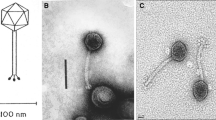Abstract
The podovirus BPP-1 is currently the only member of the Podovirus genus Rauchvirus. Here, we describe three new Caulobacter bacteriophages (Jess A, SR18, and RW) that show genetic similarity to BPP-1 but have many different genetic and structural features that differentiate them from BPP-1. Jess A and SR18 are closely related to each other and should be considered two members of a new species. They share a similar gene order with BPP-1. However, they do not appear to form lysogens or have the tropism switching mechanism that has been described for BPP-1. Bacteriophage RW also exhibits some homology to BPP-1. However, it is quite different from the other three phages, and we propose that it should be considered a representative of a third species of the genus Rauchvirus. Taken together, the differences among these four members of the genus Rauchvirus indicate that this divergent genus has a long evolutionary history and that there are many more rauchviruses waiting to be discovered.


Similar content being viewed by others
References
Poindexter JS (1964) Biological properties and classification of the Caulobacter group. Bacteriol Rev 28:231–295
Agabian-Keshishian N, Shapiro L (1970) Stalked bacteria: properties of deoxyribonucleic acid bacteriophage phiCbK. J Virol 5(6):795–800
Gill JJ, Berry JD, Russell WK, Lessor L, Escobar-Garcia DA, Hernandez D, Kane A, Keene J, Maddox M, Martin R, Mohan S, Thorn AM, Russell DH, Young R (2012) The Caulobacter crescentus phage phiCbK: genomics of a canonical phage. BMC Genom 13:542. https://doi.org/10.1186/1471-2164-13-542
Ash KT, Drake KM, Gibbes WS, Ely B (2017) Genomic Diversity of Type B3 Bacteriophages of Caulobacter crescentus. Curr Microbiol 74:779–786. https://doi.org/10.1007/s00284-017-1248-4
Wilson K, Ely B (2019) Analyses of four new Caulobacter Phicbkviruses indicate independent lineages. J Gen Virol 100:321–331. https://doi.org/10.1099/jgv.0.001218
Nguyen D, Ely B (2018) A genome comparison of T7-like podoviruses that infect Caulobacter crescentus. Curr Microbiol 75(6):760–765. https://doi.org/10.1007/s00284-018-1445-9
Liu M, Deora R, Doulatov SR, Gingery M, Eiserling FA, Preston A, Duncan J, Simons RW, Cotter PA, Parkhill J, Miller JF (2002) Reverse transcriptase-mediated tropism switching in Bordetella bacteriophage. Science 295:2091–2094
Liu M, Gingery M, Doulatov SR, Liu Y, Hodes A, Baker S et al (2004) Genomic and genetic analysis of Bordetella bacteriophages encoding reverse transcriptase-mediated tropism-switching cassettes. J Bacteriol 186(5):1503–1517
Dai W, Hodes A, Hui WH, Gingery M, Miller JF, Zhou JH (2010) Three-dimensional structure of tropism-switching Bordetella bacteriophage. Proc Nat Acad Sci USA 107(9):4347–4352. https://doi.org/10.1073/pnas.0915008107
Ely B, Croft RH (1982) Transposon mutagenesis of Caulobacter crescentus. J Bacteriol 149(2):620–625
Johnson RC, Ely B (1977) Isolation of spontaneously derived mutants of Caulobacter crescentus. Genet 86:25–32
Ely B, Weppleman RM, Massey HC, Hartman PE (1974) Some improved methods in P22 transduction. Genet 76:625–631
Scott D, Ely B (2015) Comparison of genome sequencing technology and assembly methods for the analysis of a GC-rich bacterial genome. Curr Microbiol 70:338–344. https://doi.org/10.1007/s00284-014-0721-6
Ely B, Wilson K, Ross K, Ingram D, Lewter T, Herring J et al (2018) Genome evolution observed in wild isolates of Caulobacter crescentus. Curr Microbiol 76:159–167. https://doi.org/10.1007/s00284-018-1606-x
Milne I, Bayer M, Cardle L, Shaw P, Stephen G et al (2010) Tablet—next generation sequence assembly visualization. Bioinformatics 26(3):401–402. https://doi.org/10.1093/bioinformatics/btp666
Overbeek R, Olson R, Pusch GD, Olsen GJ, Davis JJ, Disz T et al (2013) The SEED and the rapid annotation of microbial genomes using subsystems technology (RAST). Nucl Acids Res 42:D206–D214. https://doi.org/10.1093/nar/gkt1226
Okonechnikov K, Golosova O, Fursov M (2012) Unipro UGENE: a unified bioinformatics toolkit. Bioinformatics 28(8):1166–1167
Rutherford K, Parkhill J, Crook J, Horsnell T, Rice P, Rajandream MA, Barrell B (2000) Artemis: sequence visualization and annotation. Bioinformatics 16(10):944–945
Darling AE, Mau B, Perna NT (2010) progressiveMauve: multiple genome alignment with gene gain, loss and rearrangement. PLoS ONE 5(6):e11147. https://doi.org/10.1371/journal.pone.0011147
Altschul SF, Wootton JC, Gertz EM, Agarwala R, Schaffer MA, AA, Yu Y-K, (2005) Protein database searches using compositionally adjusted substitution matrices. FEBS J 272:5101–5109
Kumar S, Stecher G, Li M, Knyaz C, Tamura K (2018) MEGA X: molecular evolutionary genetics analysis across computing platforms. Mol Biol Evol 35:1547–1549
Ely B (2020) Recombination and gene loss occur simultaneously during bacterial horizontal gene transfer. PLoS ONE 15(1):e0227987. https://doi.org/10.1371/journal.pone.0227987
Saitou N, Nei M (1987) The neighbor-joining method: A new method for reconstructing phylogenetic trees. Mol Biol Evol 4:406–425
Felsenstein J (1985) Confidence limits on phylogenies: an approach using the bootstrap. Evolution 39:783–791
Tamura K, Nei M (1993) Estimation of the number of nucleotide substitutions in the control region of mitochondrial DNA in humans and chimpanzees. Mol Biol Evol 10:512–526
Funding
This work was funded in part by National Institutes of Health grant GM076277 to BE.
Author information
Authors and Affiliations
Corresponding author
Ethics declarations
Conflict of interest
The authors declare that they have no conflict of interest.
Additional information
Handling Editor: Johannes Wittmann.
Publisher's Note
Springer Nature remains neutral with regard to jurisdictional claims in published maps and institutional affiliations.
Electronic supplementary material
Below is the link to the electronic supplementary material.
Rights and permissions
About this article
Cite this article
Ely, B., Liese, J., Corley, S. et al. Novel Caulobacter bacteriophages illustrate the diversity of the podovirus genus Rauchvirus. Arch Virol 165, 2549–2554 (2020). https://doi.org/10.1007/s00705-020-04791-4
Received:
Accepted:
Published:
Issue Date:
DOI: https://doi.org/10.1007/s00705-020-04791-4




